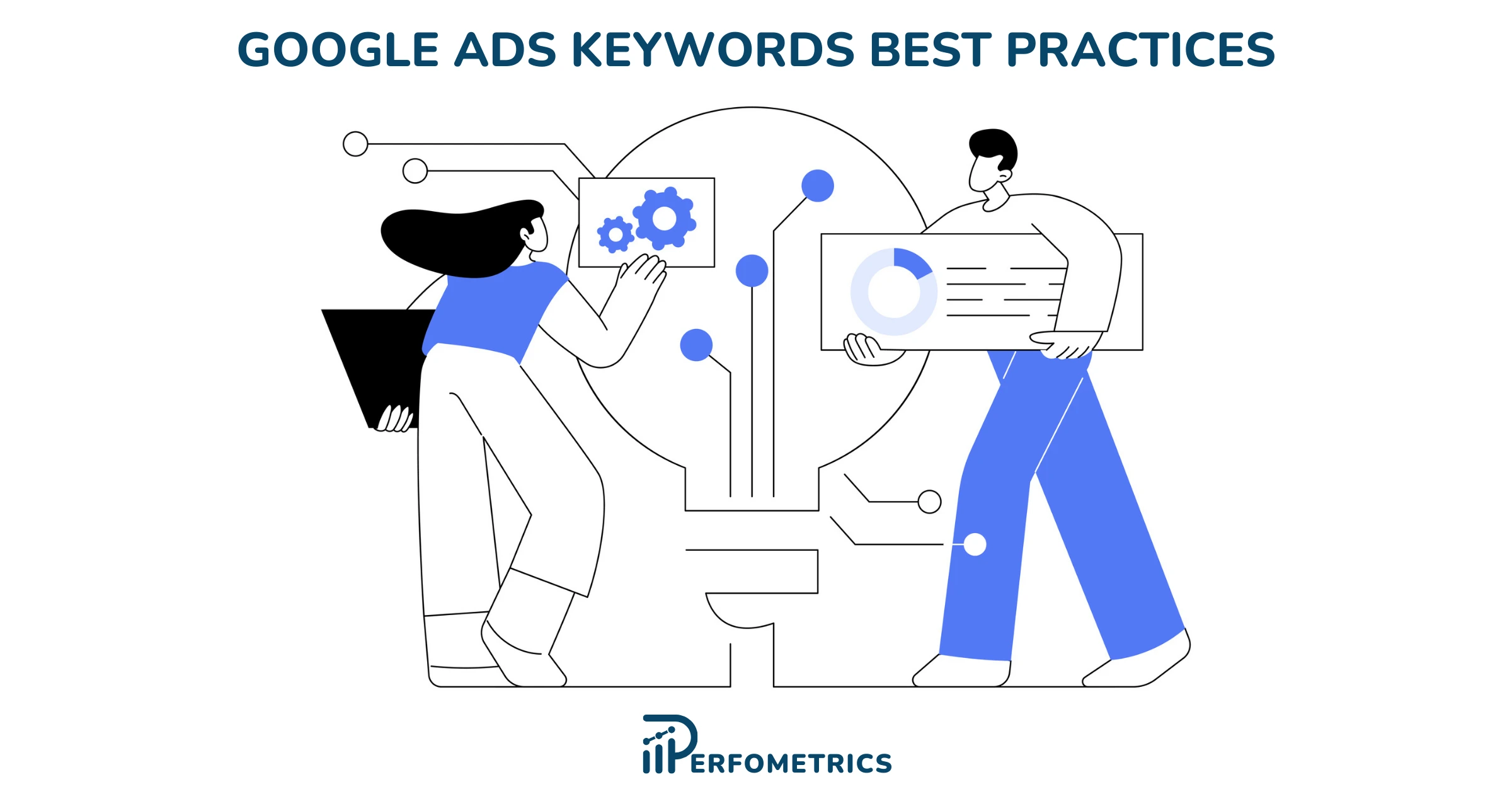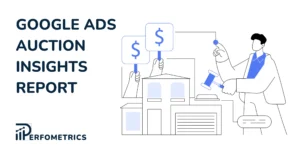Google Ads Keywords Best Practices – 6 Actionable Steps

Among the leading PPC platforms, Google Ads stands out as a powerful instrument for connecting with potential customers across the vast Google Search and Display Network and its partner sites. At the heart of effective Google Ads campaigns lies the optimization of keywords, these are search queries that trigger your ads to appear in search results.
Keyword optimization is the process of identifying, selecting, and refining keywords to maximize ad relevance, reach, and conversion rates.
For example, imagine you’re running an online store specializing in handcrafted jewelry. When a potential customer searches for “unique silver necklaces” on Google, if you are running a Search campaign type, your ad could appear alongside the search results, showcasing your exquisite collection and enticing them to visit your website. This is the magic of Google Ads keywords, enabling you to place your products or services directly in front of individuals actively seeking them online.
By following keywords best practices, you can:
- Enhance search relevance: Ensure your ads appear for the most relevant searches, increasing the likelihood of reaching genuinely interested individuals.
- Improve campaign performance: Drive higher click-through rates (CTRs), boost conversion rates, and achieve a superior return on ad spend (ROAS).
- Expand your reach: Access a vast audience across the Google Search Network and its partner sites, expanding your potential customer base.
Discover how to select the right keywords, organize them effectively, and optimize them to maximize your campaign’s impact and your Google Ads budget.
1. Conduct Thorough Keyword Research
The journey of keyword optimization in Google Ads begins with comprehensive research. This involves understanding your target audience’s search habits, analyzing industry trends, and utilizing keyword research tools to uncover relevant and high-performance keywords.
- Keyword Brainstorming: Start by brainstorming keywords related to your products, services, and target audience. Consider common search terms, industry jargon, and customer pain points.
- Keyword Research Tools: Leverage paid and free keyword research tools like Google Ads Keyword Planner and SEMrush to uncover relevant keywords, analyze search volume and competition, and identify potential opportunities
- Analyze Search Trends: Stay abreast of emerging search trends and industry buzzwords to incorporate them into your keyword strategy.
- Consider Long-Tail Keywords: Explore long-tail keywords, which are more specific and less competitive, to reach a more targeted audience and drive higher conversion rates.
- Understand Search Intent: Analyze the search intent behind potential keywords to ensure you are targeting users who are actively seeking information or solutions relevant to your offerings.
As you explore keywords, consider the following factors:
- Relevance: Prioritize keywords that are highly relevant to your products or services and align with your campaign objectives.
- Search Volume: Opt for keywords with a decent search volume, indicating sufficient potential for reaching your target audience.
- Competition: Assess the competition for your chosen keywords to determine how challenging it will be to rank high in search results.
2. Choose the Right Keyword Match Type
As you embark on your Google Ads keyword optimization journey, it’s crucial to grasp the nuances of different keyword match types and their strategic applications. Each keyword match type in Google Ads serves a unique purpose, influencing how your ads appear in search results and interact with potential customers.
- Broad Match Keywords: Cast a wide net with broad match keywords, capturing a broad range of search queries that include your keyword or variations of it. This approach can be useful for initial keyword discovery and expanding your reach, but it requires careful monitoring to ensure your ads are appearing for relevant searches.
- Phrase Match Keywords: For greater control, employ phrase match keywords, ensuring your ads appear only when the user’s search query includes the exact phrase in any order. This refines your targeting, preventing your ads from showing for irrelevant variations of your keyword.
- Exact Match Keywords: Exercise the highest level of control with exact match keywords, ensuring your ads appear only when the user’s search query matches your keyword exactly. This approach is ideal for high-intent searches where you want to guarantee your ads are displayed for the most relevant queries.
While broad match keywords offer a wider reach, their relevance may be lower. Conversely, exact-match keywords provide high relevance but may restrict your reach.
Consider the following factors when making your keyword choices:
- Campaign Goals: What do you want to achieve with your ads? What are your Google Ads goals? Are you aiming to drive website traffic, generate leads, or increase sales?
- Target Audience: Who are you trying to reach with your ads? Understand their demographics, interests, and online behavior.
- Search Intent: What are the searcher’s intentions when they enter specific keywords? Are they actively researching, comparing products, or ready to buy?
To get the best performance out of your keyword strategy, consider using a combination of broad, phrase, and exact match keywords, allocating your budget strategically across these match types. This approach allows you to capture a broad range of relevant searches while maintaining control over which queries trigger your ads.
As you gain insights from keyword performance data, refine your keyword strategy by adding high-performing keywords and removing low-performing ones. Continuously evaluate and optimize your keyword selection in Google Ads to ensure your ads are appearing for the most relevant searches.
3. Organize Keywords into Ad Groups
Once you have a solid foundation of relevant keywords, it’s time to organize them into logical ad groups. Ad groups are like thematic categories that group related keywords together, allowing you to create targeted ad copy and tailor your landing pages for specific user segments.
- Group Similar Keywords: Group keywords that share a common theme or intent together, such as “running shoes” and “athletic footwear.”
- Creating Ad Groups for Each Theme: Create separate ad groups for each theme, allowing you to craft specific ad copy and landing pages tailored to each group.
- Maintain a Clear Hierarchy: Create a clear hierarchy of ad groups, with broader categories at the top and more specific ones nested within them. This structure provides a logical framework for your campaign and facilitates easy navigation.
Create ad groups around specific themes or product categories, such as “running shoes for men,” “running shoes for women,” or “running shoes for different terrains.” This thematic organization ensures that your ads are highly relevant to the specific search terms within each ad group.
4. Leverage Keyword Insights
As your Google Ads campaigns accumulate data, a treasure trove of keyword insights emerges, unveiling valuable information about search terms, user behavior, and campaign performance.
By harnessing these insights, you can make informed decisions to optimize your keyword lists, enhance ad copy, and refine your bidding strategies for maximum impact.
Google Ads provides a wealth of data about your keywords, including:
- Search Terms: Discover the exact terms users enter to trigger your ads.
- Click-Through Rate (CTR): Measure the percentage of people who click your ads after seeing them.
- Conversion Rate: Assess how many people who click your ads take a desired action, such as making a purchase or signing up for a newsletter.
- Cost-Per-Click (CPC): Determine the average amount you pay for each click on your ads.
Google Ads provides detailed search term data, revealing the exact phrases users enter to trigger your ads.
Analyze this data to identify:
- High-Converting Search Terms: Discover which search terms consistently lead to conversions, indicating areas of focus for your keyword strategy.
- Irrelevant Search Terms: Identify search terms that aren’t directly related to your products or services, indicating the need for negative keyword adjustments.
- New Keyword Opportunities: Uncover new, relevant keywords that users are searching for, expanding your keyword list and potential reach.
Recognize and prioritize keywords that consistently generate high CTRs, conversion rates, and ROAS. These high-performing keywords are driving value for your campaigns and should receive increased attention in terms of bidding and ad copy optimization.
Address keywords that consistently underperform, displaying low CTRs, conversion rates, or high CPCs. Consider pausing and adding as negative underperforming keywords to improve the overall efficiency of your campaigns.
Embrace data-driven decision-making, stay up-to-date with the latest Google Ads features, and never stop seeking opportunities to optimize your keywords for best performance.
5. Utilize Negative Keywords
Negative keywords are like gatekeepers, preventing your ads from appearing for irrelevant searches and ensuring that your ad spend is directed towards genuinely interested users.
- Identifying Irrelevant Keywords: Review your search terms report to identify irrelevant search terms or bad performers that are triggering your ads. These terms become your negative keywords, ensuring that your ads are only shown to users who are genuinely interested in your offerings.
- Adding Negative Keywords: Add negative keywords in Google Ads to your campaigns or create a list that you can apply to multiple campaigns, to prevent your ads from showing for irrelevant searches, saving you money and improving ad relevance.
- Regularly Review Negative Keywords: As your campaigns evolve and search trends change, regularly review your negative keyword lists to ensure they are effectively excluding irrelevant traffic.
6. Track Keyword Performance
Regularly review your keyword performance data to identify trends, patterns, and areas for improvement. Monitor metrics such as CTR, conversion rate, CPC, and ROAS for individual keywords, ad groups, and campaigns.
By measuring key performance indicators (KPIs), you can gain valuable insights into how your keywords are performing, identify areas for improvement, and make data-driven decisions to optimize your campaigns for success.
Essential KPIs for Keyword Performance:
- Click-Through Rate (CTR): Measures the percentage of people who click on your ads after seeing them. A higher CTR indicates that your ads are relevant and engaging, enticing users to click and learn more about your offerings.
- Conversion Rate: Assesses the percentage of people who click on your ads and take a desired action, such as making a purchase, signing up for a newsletter, or downloading a resource. A higher conversion rate demonstrates that your ads are effectively converting clicks into desired outcomes.
- Cost-Per-Click (CPC): Determines the average amount you pay for each click on your ads. A lower CPC indicates that you are efficiently acquiring clicks and maximizing your ad spend.
- Return on Ad Spend (ROAS): Measures the profitability of your advertising efforts by comparing the revenue generated from conversions to the total amount spent on advertising. A higher ROAS indicates that your campaigns are generating a positive return on investment.
Evaluating Keyword Performance:
- Analyze Individual Keyword Metrics: Assess the performance of each keyword by examining its CTR, conversion rate, and CPC. Identify keywords that consistently perform well and those that require improvement.
- Compare Keyword Performance Across Groups: Compare the performance of keywords within ad groups to identify patterns and potential areas for optimization. This analysis can reveal which ad groups are driving traffic and conversions effectively and which ones need refinement.
- Benchmark Keyword Performance Against Industry Standards: Compare your keyword performance metrics to industry benchmarks to assess your campaigns’ relative effectiveness. This benchmarking can help you identify areas where you may need to adjust your strategies to stay competitive.
- Monitor Ad Group Performance: Regularly monitor the performance of each ad group, identifying high-performing and underperforming ones. Use this data to refine your keyword selection and ad copy optimization strategies.
Continuously monitor your keyword performance data to identify changes in trends, patterns, and areas for improvement. Use these insights to refine your keyword selection, bidding strategies in Google Ads, and ad copy, ensuring your campaigns are consistently optimized for maximum performance.
Conclusion
By following these Google Ads keywords best practices, conducting thorough keyword research, utilizing negative keywords effectively, organizing keywords into logical ad groups, and monitoring and optimizing keywords in Google Ads, you lay the groundwork for successful campaigns, ensuring that your ads reach the right customers and deliver the desired results.



